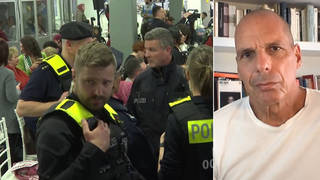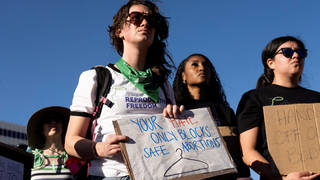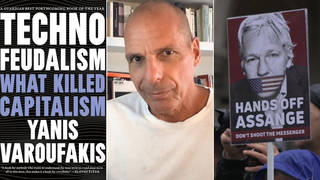
Related
Topics
Guests
- Dr. Atul Gawandea surgeon at the Brigham and Women’s Hospital in Boston, a staff writer at The New Yorker and professor at Harvard Medical School. He is the author of several books, including The Checklist Manifesto: How to Get Things Right. His most recent book is Being Mortal: Medicine and What Matters in the End.
Despite our advances in medicine, a new book calls for a radical transformation in how we approach the end of life. In “Being Mortal: Medicine and What Matters in the End,” the physician and best-selling author Dr. Atul Gawande argues that a rigid focus on prolonging life can often undermine what is best for a dying patient. “Medical science has rendered obsolete centuries of experience, tradition, and language about our mortality,” Gawande writes. “Our reluctance to honestly examine the experience of aging and dying has increased the harm we inflict on people and denied them the basic comforts they most need.” A surgeon at the Brigham and Women’s Hospital in Boston, Gawande is an acclaimed staff writer at The New Yorker and a professor at Harvard Medical School. “Being Mortal” is his fourth book, following the best-selling “The Checklist Manifesto: How to Get Things Right.”
Transcript
AARON MATÉ: For all of our advances in medicine, we turn now to a new book that calls for a radical transformation in how we approach the end of life. In his latest book, Dr. Atul Gawande argues that a rigid focus on prolonging life can often undermine what’s best for a dying patient. Dr. Gawande writes, quote, “[M]edical science has rendered obsolete centuries of experience, tradition, and language about our mortality and … [o]ur reluctance to honestly examine the experience of aging and dying has increased the harm we inflict on people and denied them the basic comforts they most need.”
AMY GOODMAN: The book is called Being Mortal: Medicine and What Matters in the End, by our guest, the physician and best-selling author Dr. Atul Gawande, surgeon at Brigham and Women’s Hospital in Boston, staff writer at The New Yorker, professor at Harvard Medical School. This is his fourth book, with the others, The Checklist Manifesto: How to Get Things Right. I wanted to go to the first line of your introduction, Atul. You say, “I learned about a lot of things in medical school, but mortality wasn’t one of them.”
DR. ATUL GAWANDE: Yeah. We don’t teach about—we teach doctors how to try to save people. We teach very little about how we manage the realities of what we cannot fix. And the place we’ve ended up in is a health system that not only has the basic public health failures we described in the previous segment, but then this other failure, which is the ability to manage mortality. I have been a surgeon for more than a decade now in cancer surgery, taking care of a lot of people who’ve died, and could see that my own skills were inadequate for helping people navigate what is normal: denial, anxiety, the desire to have everything thrown at you.
And there have been this series of studies that have brought home how badly this is going. A study at the Mass General Hospital is just one example. They took lung cancer patients, stage IV cancer patients, who had on average just 11 months that they lived after the study started. Half of them got usual oncology care. The other half got usual oncology care plus a palliative care physician who had discussions with them early in the course about what happens if and when things don’t work out so well. The group who got the conversations ended up spending fewer days in the hospital, stopped chemotherapy earlier, went on to hospice sooner, had less suffering at the end of their lives, and they lived 25 percent longer. We are making bad decisions, because we are unwilling as a profession and as families to begin earlier the discussions and planning for how we deal with end-of-life or just the aging process.
AARON MATÉ: You profile many cases in your book where patients suffer because of an inability to reckon with death or a refusal to do so. I’m wondering if you can profile one of them for us, Sara Thomas Maloney [sic].
DR. ATUL GAWANDE: Yeah, Sara Monopoli. So, this was one that brought home to me—she was a 34-year-old woman who was diagnosed, in her eighth month of pregnancy, with metastatic lung cancer. I mean, this is as hard as you possibly can get. And she knew it was not curable. But you want treatments that can extend the time you had. She got her infant baby and wanted to spend as much time as she could with her new daughter. But she knew the end would come. We all had a plan that we would not have this end with, you know, flogging her to the bitter end and having no quality of life in the end. And yet, we still—the train still went down that track. And I was part of that team and made that happen.
What I found was that we had an inability to recognize, and even ask questions about, the fact that people have priorities besides just living longer, priorities that include things like, well, I really care about whether my brain works as time goes on, whether I’m suffering with daily pain or not. The power that comes from the fact that we can have discussions was reflected to me in my own father’s case, where he had a brain cancer in his brainstem and spinal cord. We had the conversations that I learned from palliative care physicians and others.
AMY GOODMAN: And explain when you say “palliative care.”
DR. ATUL GAWANDE: Yeah, so palliative care is the specialty that has evolved for how to make sure that people’s well-being is preserved in the course of their life, especially when they have chronic illness or terminal illness. Palliative care is often paired with hospice, where if you reach the stage where you’re at the last six months of your life, you can be eligible to move into care that’s really about having your best possible day today, instead of sacrificing your time today for the sake of the future.
So, what the people in palliative care do is they just have some basic questions that we don’t ask and never learned in medicine, things like, you know, “Tell me what your understanding of your condition is,” “Tell me what your fears and your worries are about the future,” “Tell me your goals, if time becomes short,” and “Tell me what outcomes are unacceptable to you.” That was what we failed to ask Sara Monopoli. But when we asked them for my father going through his brain cancer, that gave us the direction where we understood, you know, what really mattered to him. He was a social person. He was a very active person. So, he went through surgery to preserve that capability. But when chemotherapy started to take that away, that’s when we stopped.
AMY GOODMAN: Talk about your grandfather, because that goes to the issue of how cultures honor aging or marginalize people who are getting older.
DR. ATUL GAWANDE: Yeah. My grandfather had the kind of old age that I think we’re nostalgic for. He actually lived in a rural village until the age of 110 in India. Thirteen children. He was surrounded by family all the way to the end. If he was in America, he would have been in a nursing home in the last years of his life. Instead, he was supported by family, at the head of the dinner table every night, often consulted on business decisions still and marriages right to the end. It was a way that we wish we all could have.
But the reason it worked was because it enslaved young people. And enslaving young people meant that it was often young women whose futures were tied to what happened to his future. And the progress of countries, whether it was us in the 19th century or India and China and Korea today, comes from giving young people their freedom to work where they want, live where they want, to marry whom they want.
AMY GOODMAN: You’re saying it enslaved young people.
DR. ATUL GAWANDE: Yeah, yeah. I mean, he had sons in their eighties still wondering when they would inherit land so they could have a living in the future. So, you know, we moved to a place of freedom. And moving to freedom meant that young people went to the city. They became more prosperous. But we had no plan, whether it was the 19th century in America or 21st century today in India, for what happens with the elderly left behind.
And our answer became: Medicine will take care of that. Medicine has proved to be an extraordinarily expensive way to take care of it. Great when we have treatments that can repair problems, replace an arthritic knee, like my mother had just a couple years ago, but when it’s a problem that has only mounting difficulties—my father’s brain cancer, simply the old age of my grandfather—putting people in the hospital and expecting that that’s going to fix things doesn’t work.
AARON MATÉ: You mentioned the nursing home. What’s your main critique of that system, and how should it be reformed?
DR. ATUL GAWANDE: So the main difficulty we have is that by putting medical values into the places that take care of us as we face the realities of mortality, it extends well before end of life. It happens when you start needing help, because you, you know, simply can’t get around it anymore. You move into a nursing home, though, and health and safety and survival are their top values. And the result is, you lose what matters to you in life, which includes your own freedom.
In nursing homes—you know, I describe the case of my wife’s grandmother, who entered a nursing home around the same time my grandfather in India was aging. And her experience was, she couldn’t wear the shoes she wanted, because they weren’t safe: The heels were too high. She had no privacy, because no one cared—no one focused on that, because that’s not a matter of safety or survival. She couldn’t eat the food she wanted, because that could be—some of it could be safe. You know, you’ll see the biggest complaint with Alzheimer’s patients, for example, is that they won’t stick to just eating the puréed food they’re supposed to eat. And you’ll see Alzheimer’s patients who will hoard cookies. Give them the damn cookies. Let them have something more to live for than just safety and survival.
And that’s what—there’s a whole group of pioneers—some of them call themselves “nursing home abolitionists”—who are remaking how senior care works. You know, I think we get really excited about the innovation of what technologies can do. To me, some of the most exciting innovation in America is happening in the ways that people are redesigning the places we care for the elderly, so that they can make choices and have lives they want to live.
AMY GOODMAN: Isn’t part of the problem is that they are segregated, that there’s no longer that intergenerational atmosphere around them? This remarkable film that came out of Sundance of a social worker—it was called Alive Inside—who goes into nursing homes and puts earphones on older people who have been—haven’t contacted—in contact in the world at all, almost seemed comatose. And suddenly they come alive. And what they’re doing now is, kids are coming in after school with their favorite music, playing it for older people. It might not even be just the music. It might be the kids with the older people.
DR. ATUL GAWANDE: I profile a retirement home with nursing home facilities that’s also attached to a school. And the elderly go in and teach classes. Just because you’re in a wheelchair doesn’t mean you can’t contribute anymore. They go in and teach and tutor in the library, and vice versa: The students take courses and then take care of the elderly with exceptional needs. I tell the story of a young man who cared for, as part of his school, an elderly man who died after severe dementia. And the family had him give the eulogy at his funeral. You know, there is this possibility. And some of these places are—there’s experiments in every state in the country now that have created places like these. And we need to see—and they don’t even cost more. This is just a mentality that we have to have.
AMY GOODMAN: I was deeply moved in your book about the geriatric ward floor that you never even bothered to walk into, you said; for all the years, you just passed it. Talk about the experience of sitting there with the lead geriatrician and his patient, Jean.
DR. ATUL GAWANDE: Yeah. This brought home to me how we are utterly failing to teach basic skills that geriatricians understand. So, he had a—
AMY GOODMAN: And what is a geriatrician?
DR. ATUL GAWANDE: A geriatrician takes care of the elderly people, predominantly over age 75 or 80, who are developing the problems of aging. You know, so, a hard person—you know, how do you say to mom, “Let’s go see a geriatrician today,” right? But when he saw his patients, he would be willing to take the time to deal with—they have high blood pressure, they have bad knees, they have—you know, this past lung cancer this woman had. They have a lot of issues. And what he recognized was: How do you cut through that to recognize what the most threatening concerns are for a person’s life and what they want?
AMY GOODMAN: Well, tell us Jean’s story, because it really was astonishing what you thought was important—
DR. ATUL GAWANDE: Yeah.
AMY GOODMAN: —and what this doctor thought was important.
DR. ATUL GAWANDE: So, what I thought most important was there was a nodule seen on her lung film, on an X-ray, that might be a possible cancer—maybe, maybe not. And what the doctor said was that—the geriatrician recognized the most significant danger to this woman was she was going to fall. And he recognized that by looking really carefully at her feet, knowing how to examine the feet. We don’t even teach that, honestly.
AMY GOODMAN: Well, explain. He said to her, “Take off your shoes.”
DR. ATUL GAWANDE: Yeah. He said every patient has to be examined with their shoes and socks off. He would watch how they took off their socks and shoes, to see whether they were able to reach down enough to actually care for their own nails, whether—what the condition of the toenails were, whether there were callouses.
AMY GOODMAN: And why does that matter?
DR. ATUL GAWANDE: And it matters because those are the things that—if you have painful feet, they make you unstable. He recognized that the woman was on multiple medications, some of which were dehydrating her and making her dizzy. He recognized that her nutritional issues were—
AMY GOODMAN: Well, wait. That issue of medication, there is an interesting rule you had—he had, which has to do with having more than four meds, drugs.
DR. ATUL GAWANDE: Yeah. This is not just his rule. This is research evidence that most doctors don’t even know. A patient who is on more than four drugs is at much higher risk of having falls. A patient who has a certain nutritional history, like having some loss of weight, much higher risk of having falls.
So, for this woman, the biggest danger to her of losing her way of life was that she would fall, break her hip, end in a nursing home, and then 50 percent chance of death six months later. So what he did, he changed her medications. He simplified them. He worked on having her see a podiatrist to take care of her feet. And he changed her nutrition. A year later, she had maintained her weight, still living her apartment on her own in her mid-eighties, and doing remarkably well.
We don’t teach geriatrics to 97 percent of our medical students in the country. The geriatrics profession has fewer people who are being trained in it today than a decade ago, even though our numbers of people who need these skills are exploding. This has been our failure to value the skills that absolutely matter most to our future, what I will care about when I’m at that stage.
AMY GOODMAN: Do you think if we had a single-payer system in this country, where the government was concerned about the costs—we pay far more for older people, right, going after that nodule, as opposed to whether she was balanced—than if we had a system where cost mattered and actual human conditions matter of a patient?
DR. ATUL GAWANDE: Well, the irony here—so, there are many things a single-payer system may be able to make better. But we have a single-payer system for the elderly, and it has not served these needs. We—
AMY GOODMAN: Medicare.
DR. ATUL GAWANDE: Medicare, our Medicare system. Some of it is for political reasons, right? We do not reward—one of the lowest-paid professions in the country is being a geriatrician. Add to it that we’ve had this political debate, where making sure physicians are paid for the time to have conversations about the needs of people as they face the end of life or face their mortal problems, that even that was a political—
AARON MATÉ: It was a death panel.
DR. ATUL GAWANDE: It was accused of being a death panel. I think we’re beyond that now. And part of the reason to write this book now is that we have been able to—I think we’re moving beyond, in both parties, the idea that this is about death panels. This is about assuring people that—not that they have a good death. That is not the goal. The goal is as good a life as possible all the way to the very end.
AMY GOODMAN: We’re talking to Dr. Atul Gawande, who is a surgeon at Brigham and Women’s Hospital in Boston, a staff writer for The New Yorker, and is just out with his new book. It’s called Being Mortal: Medicine and What Matters in the End. We’ll continue our discussion in a minute.
[break]
AMY GOODMAN: This is Democracy Now!, democracynow.org, The War and Peace Report. I’m Amy Goodman, with Aaron Maté. Our guest for the hour is Dr. Atul Gawande, a surgeon at Brigham and Women’s Hospital in Boston, staff writer at The New Yorker, professor at Harvard Medical School, author of a number of books, including The Checklist Manifesto and his latest, Being Mortal: Medicine and What Matters in the End. Aaron?
AARON MATÉ: Yes, I wanted to ask you—in the book, you talk about a choice that patients are often faced with, in terms of choosing hospice care, which is translated to giving up or equated with giving up, and then choosing dangerous, invasive procedures, which is perceived as that’s the fight.
DR. ATUL GAWANDE: Yeah. This is where I found I was—I would pose options to people, and it would always be about, well, do you want to fight, or do you want to give up? And I knew that wasn’t the right way to think about it, but I didn’t know how we might be able to think about it better. And what I realized was this frame of—it’s really about: What are we fighting for? So, you know, the people that I saw in hospice, what was amazing to me, as I watched the work they did, they were fighting, too. They were fighting for giving people a good day. And the idea of what our goals are, it boils down to—medicine ordinarily says we will sacrifice your time now for the sake of time in the future. But we have to be open to the idea that what people may want is to have us fight for “I want to have just my best possible day today,” and use the medical capabilities to accomplish that. It doesn’t have to happen that that only happens in hospice. And that has been a huge mistake. If we orient ourselves towards the concept that we need to communicate to our doctors, if they aren’t asking these questions, communicate to them what our best possible day is, what the life that’s worth living for us is, tell people our fears and anxieties, tell them our goals for what happens if our health worsens and what outcomes are unacceptable, then we can have a health system that actually drives towards what we’re trying to achieve. And the irony is, it is lower-cost and helps people live longer.
AMY GOODMAN: Dr. Gawande, you published a study in The Journal of the American Medical Association that found hospitals make a lot more profit when an insured surgical patient develops complications than if it comes off without a hitch, the operation.
DR. ATUL GAWANDE: I did. What I was looking at was this perversity in our system that we will pay more and more for procedures, but, you know, if there’s a complication, it actually turns out that the profit margin goes up for hospitals. So then, what is your incentive to invest in keeping people out of the hospital, making sure the care is appropriate and not inappropriate, and then making it as safe as possible? No hospital is trying to profit by increasing their complications and deaths, right? The main issue is that you just simply don’t invest in it. In my office, for example, we will hire a whole phalanx of people to check insurance numbers, and it always pays to hire one more to triple-check the insurance referral numbers. But hire one more nurse who could contact the patients earlier, keep them out of the hospital by catching problems after they’ve left from the operations I do, you have to fight for it, because there’s no margin in being able to pay for that.
AARON MATÉ: I wanted to ask you about the issue of assisted suicide. Brittany Maynard is a 29-year-old woman diagnosed with an aggressive form of terminal brain cancer. She’s using the last weeks of her life to advocate for expanding Americans’ access to doctor-assisted suicide. Maynard moved from California to Oregon so she could benefit from its “Death with Dignity” law. This is an excerpt from a video she appears in about the life-ending medication she gained access to in Oregon.
BRITTANY MAYNARD: I don’t wake up every day and look at it. It’s in a safe spot, and I know that it’s there when I need it. I plan to be surrounded by my immediate family, which is my husband and my mother and my stepfather and my best friend, who’s also a physician, and probably not much more people. And I will die upstairs in my bedroom that I share with my husband, with my mother and my husband by my side, and pass peacefully with some music that I like in the background.
AARON MATÉ: That’s Brittany Maynard. She has chosen to die on November 1st, so she can celebrate her husband’s birthday with him the previous day. Your take on this issue of assisted suicide?
DR. ATUL GAWANDE: Look, I think that if we are unwilling to recognize that when people have unbearable suffering that we can do nothing about, that they need to be allowed to have an option where they can relieve that suffering. And if I had the chance to vote for whether I’d allow for a safe approach, like they’ve been taking in Oregon and Washington, I would be in favor. However, I’m worried about the goal that a good death is our aim. The goal is as good a life as possible all the way to the very end. And the fear and concern that Brittany has is that they won’t be allowed that possibility, that they will just have suffering towards the end. About less than 1 percent of patients in Washington and Oregon end up choosing this option. And what’s really interesting to me is that just having the medication, less than half of them end up actually using it. It just relieves them to know that they have that option if it needs to be there.
The critical parts are that we have the capability to relieve pain, to relieve nausea, to relieve many of the terrible symptoms that people have. And we also have the capacity to help them recognize and achieve goals that they might have as they come to the end, everything from being able to say goodbyes to people to—you know, I tell the story of my daughter’s piano teacher, who was suffering in tremendous pain; when it finally got under control, on hospice, said, “I want to teach my students again.” And my daughter had four lessons with her before—in her last weeks of life and then a final recital. And what that woman was able to pass along to the children she taught, she didn’t even dream was possible. She might have chosen assisted suicide in that moment of pain when no one was doing anything.
AMY GOODMAN: I just wanted to read to you what a viewer just wrote in, said, “A life as good as possible right to the end should include the far cheaper attendant care at home for people who don’t need nursing homes but get sent there anyway, because the system rewards nursing homes. Medicare does not pay for home care attendants, which is much cheaper.”
DR. ATUL GAWANDE: Yeah, and the listener is right. The ability to build—first of all, what people most want is the ability to be at home. And there’s two ways in which we mean that. Number one is that we are able to provide services for far less that can sustain people longer in the home, and we aren’t doing it adequately. Second is that in the place—when you reach the point that you actually can’t remain in the home, we put people in nursing homes that actually feel much more like hospitals. People have no control. There is redesign of many of these places to make it so that they’re smaller, with just a dozen people, and it’s not organized around a nursing station, it’s organized around a kitchen. The elderly are allowed to go in and open up the kitchen door and have what they want, which is regarded as—previously regarded as unsafe. Well, that’s why people want to be in their homes as long as possible. There is a whole movement called the “villages movement,” that provide basic services like, you know, access to a plumber and someone who can change your light bulb and someone who can fix your telephone, that you—that are the very crises that can drive you into a nursing home. And it doesn’t take that much cost at all.
AARON MATÉ: In Mexico, they have the Day of the Dead, where families come together and honor relatives and friends who have passed, and they reckon with loss. We’re a culture here that’s violent but does not deal with death in any approachable way to Mexico. Why do you think this society is so averse to death?
DR. ATUL GAWANDE: Well, actually, I think it’s changing. So, there’s an interesting, important statistic that’s happening right now that I don’t think we recognize. In 1950, the majority of Americans died in their home. By the end of the 1990s, it was just 17 percent. In the last five years, however, the number of people choosing hospice has now grown to almost 50 percent, so that people are shifting and having that experience and seeing it happen, not behind closed curtains, but bringing hospice either home or in a hospice center outside of hospital and nursing home kind of institutions. And that is a remarkable change. We’re all starting to have that experience that, you know, death is terrible, but death is normal.
AMY GOODMAN: What most shocked you, Dr. Atul Gawande, in writing this? You’re at the top of the hierarchy as a surgeon. You say geriatricians are at the bottom. What most shocked you, and what most—is most important to change?
DR. ATUL GAWANDE: What most shocked me was how simple the change turns out to really need to be—and the change is simply recognizing that people have priorities besides living longer—and that the most powerful thing we can do is ask people what their priorities are. We don’t. We don’t do it as families. We don’t make it a priority in the homes where we take care of folks. And we don’t do it in hospitals. And, you know, this is driving tremendous cost. More importantly, it’s driving suffering. And there’s this core idea that is the surprise to me that there is the possibility of still achieving a potential in your life even in your last weeks of life, that there are amazing things that can happen, like the story of my daughter’s piano teacher. That, to me, represents a picture of the future that we can have.
AMY GOODMAN: Well, Dr. Atul Gawande, we want to thank you for being with us, for writing this book and your others. Dr. Gawande is a surgeon at the Brigham and Women’s Hospital in Boston, staff writer at The New Yorker magazine, where you may have read many of his pieces. He’s a professor at Harvard Medical School, author of a number of books. The Checklist Manifesto: How to Get Things Right is one of them, and his most recent is Being Mortal: Medicine and What Matters in the End.
That does it for today’s broadcast. If you’d like to get a copy of today’s show, a DVD, you can go to our website at democracynow.org. I’ll be speaking at Trinity University tonight at 7:00 at San Antonio, Texas. On Thursday, I’ll be at University of Michigan-Flint, and on Friday night in Santa Fe, New Mexico. Just check our website at democracynow.org.












Media Options